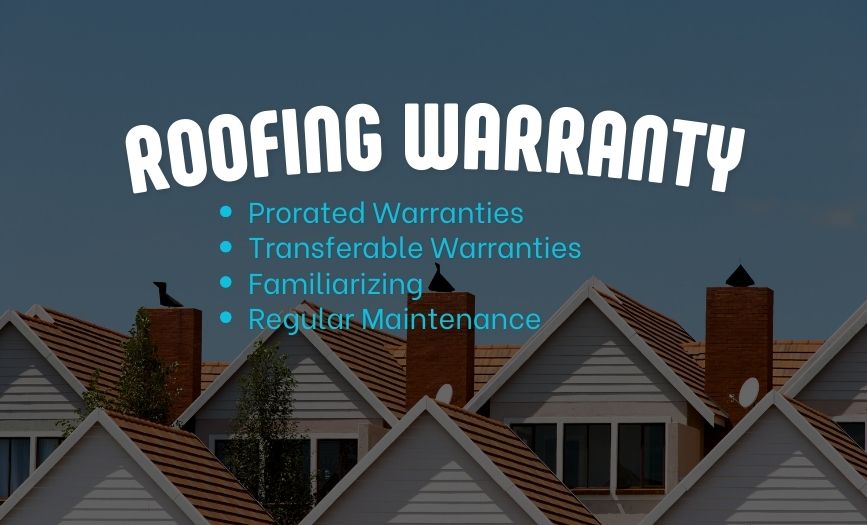Hey there, fellow homeowners! We’ve got some valuable insights to share about roofing warranties and how they impact replacement costs. In this article, we’ll dive into five essential tips that’ll help you navigate these warranties like a pro.
From understanding coverage and exclusions to factors that influence replacement costs, we’ve got you covered. So, sit back, relax, and let’s explore how to make the most out of your roofing warranty and protect your investment.
Let’s get started!
Key Takeaways
- Prorated warranties provide decreasing coverage based on roof age
- Transferable warranties can be transferred to new homeowners
- Familiarizing with exclusions helps prepare for replacement costs
- Regular maintenance can prolong roof life and reduce repairs
Types of Roofing Warranties
There are several types of roofing warranties that homeowners should be aware of when considering a replacement. Two common types are prorated warranties and transferable warranties.
Prorated warranties provide coverage that decreases over time, typically based on the age of the roof. This means that the longer you have the roof, the less coverage you may receive.
On the other hand, transferable warranties allow the homeowner to transfer the warranty to a new owner if they decide to sell the house. This can be a valuable selling point and may increase the value of the property.
It’s important to understand the terms and conditions of each warranty before making a decision, as they can vary between manufacturers and roofing contractors.
Understanding Coverage and Exclusions
Our roofing warranties provide coverage and exclusions that homeowners need to understand when it comes to replacement costs.
It’s important to be aware of the limitations of your roofing warranty to avoid any surprises down the line.
Common exclusions in roofing warranties include damage caused by natural disasters such as earthquakes, hurricanes, or floods. Some warranties may also exclude damage caused by improper installation or maintenance.
It’s crucial to thoroughly read and understand the terms and conditions of your roofing warranty to determine what’s covered and what’s not.
By familiarizing yourself with the exclusions, you can better prepare for any potential replacement costs that may arise in the future.
Factors That Influence Replacement Costs
To understand the factors that influence replacement costs, we need to delve deeper into the specifics of roofing warranties. One of the main factors is the type of roofing material you choose. Different materials have varying costs and lifespans. For example, asphalt shingles are generally more affordable but have a shorter lifespan compared to metal or tile roofs.
Additionally, the maintenance techniques you employ can also impact replacement costs. Regular roof maintenance, such as cleaning gutters, removing debris, and inspecting for damage, can help prolong the life of your roof and reduce the need for costly repairs or replacements. On the other hand, neglecting maintenance can lead to more significant issues and higher costs down the line.
Therefore, choosing the right roofing material and implementing proper maintenance techniques are crucial in determining replacement costs.
Importance of Reading Fine Print
When it comes to roofing warranties and their impact on replacement costs, it’s essential for homeowners to carefully read the fine print. The importance of research can’t be overstated in this regard.
Many roofing warranties may seem comprehensive at first glance, but hidden within the fine print are potential hidden costs that could significantly impact the overall replacement expenses. By taking the time to thoroughly read and understand the terms and conditions of a roofing warranty, homeowners can avoid surprises and make informed decisions.
It’s crucial to identify any exclusions, limitations, or requirements that may affect the warranty’s coverage. Additionally, researching the reputation of the roofing manufacturer and installer can help homeowners gauge the reliability and credibility of the warranty.
Maximizing Warranty Benefits
One key way to maximize the benefits of a roofing warranty is by understanding its coverage and limitations. By thoroughly reading and comprehending the terms and conditions of the warranty, you can ensure that you’re aware of what’s covered and what’s not.
Another way to maximize warranty benefits is by extending coverage. Some roofing manufacturers offer the option to purchase extended warranties that provide additional protection beyond the standard warranty period. This can be beneficial in case any unexpected issues arise after the initial warranty period expires.
Additionally, warranty transferability is another factor to consider. Some warranties can be transferred to a new homeowner if you decide to sell your property. This can be a valuable selling point and may increase the resale value of your home.
Conclusion
In conclusion, understanding roofing warranties is crucial in determining replacement costs. By familiarizing ourselves with the different types of warranties and their coverage, we can make informed decisions about our roof’s protection.
It’s essential to read the fine print and consider factors that may influence replacement costs. By maximizing warranty benefits, we can ensure long-term savings and peace of mind.
Remember, the devil is in the details, so don’t overlook the importance of a comprehensive roofing warranty.

